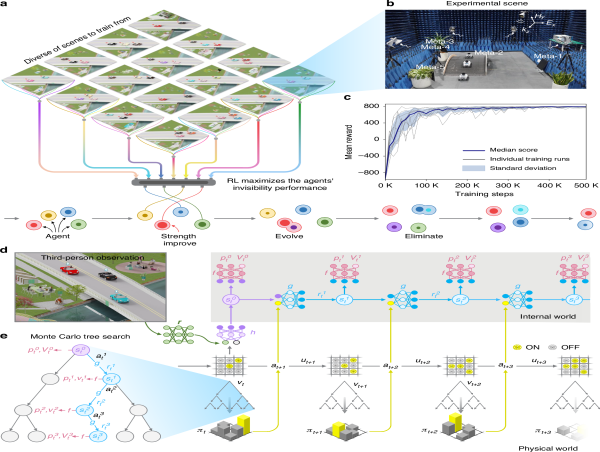GA, UNITED STATES, June 18, 2025 /EINPresswire.com/ -- Recently, a groundbreaking study entitled "MetaSeeker: sketching an open invisible space with self-play reinforcement learning" by the research group of Prof. Chao Qian and Prof. Hongsheng Chen at Zhejiang University was published in Light: Science & Applications.
This research proposed MetaSeeker, short for seeking in the metasurface space. MetaSeeker utilizes a population of reinforcement learning (RL) agents that construct an internal world to mirror the physical world in a unique way, facilitating a comprehensive grasp of intricate physical dynamics in the disordered systems within an exceptionally brief timeframe. By manipulating a team of metasurfaces that orchestrate the free management of electromagnetic waves through intricate internal scattering, MetaSeeker effectively conceals any moving objects in the designated 3D space.
Background
The dream of being invisible was considered almost impossible until the advent of metamaterials and metasurfaces. Different methodologies have been successively proposed, such as transformation optics, near-zero refractive index, scattering cancellation, and topological protection. However, a common feature for all related works is to clad an interested object with a carefully-designed metamaterial coating or metasurface inclusion to formulate a closed space, greatly hindering its flexibility and maneuverability. This research starts from a completely different view, that is, is it possible to directly render an open and cluttered space invisible?
MetaSeeker Algorithm
MetaSeeker adopts a two-tier optimization approach by incorporating model-based RL and population-based training, as depicted in Fig. 1a. Population-based training (PBT) adjusts the hyperparameters of RL procedure (Dirichlet exploration noise, regularization parameter, and learning rate) by replacing underperforming agents with mutated versions of superior agents. This autonomous process enables the continual improvement, evolution, and adaptation of agents within the population, aligning seamlessly with Darwin's theory of evolution and eliminating the need for human intervention. Simultaneously, the RL agents aim to optimize the distributed metasurfaces, with each meta-atom toggling between ON and OFF states. Inspired by the related model, MuZero's proficiency in board games, the metasurface optimization is liken to board gameplay. This involves adjusting meta-atom's phase based on piece placement, aiming to maximize invisibility performance.
Equipped with a comprehensive perception-decision-execution accessory, multiple RL agents autonomously interact with the physical world, conducting on-site learning based on far-field feedback. Such self-optimization mechanism enables robust handling of extremely rich inputs in metasurface space and kaleidoscopic environments. Repeated evaluations suggest that the detected far-field signals maintain stable when different hidden objects freely move inside the EM invisible space.
Results
Experiment illustrates MetaSeeker knowledge representation and response time development over 500,000 training steps. As training progresses, MetaSeeker ascends from a grasp of superficial insights to profound understanding, paralleled by an augmentation in immune/invisibility performance and a reduction in response time. Ultimately, it achieves near-perfect immune effect within milliseconds, allowing the decision-making process to be disregarded.
The research group also conducted an interpretability analysis on MetaSeeker, as depicted in Fig. 2d, with red and blue pixels signifying regions where the objects respectively increase and decrease the far-field intensity. The analysis elucidates that the antagonistic influences of interferences and metasurfaces are capable of counterbalancing each other (intricate scattering cancellation) on the far-field intensities.
References
DOI
10.1038/s41377-025-01876-0
Original Source URL
https://doi.org/10.1038/s41377-025-01876-0
Lucy Wang
BioDesign Research
email us here
Legal Disclaimer:
EIN Presswire provides this news content "as is" without warranty of any kind. We do not accept any responsibility or liability for the accuracy, content, images, videos, licenses, completeness, legality, or reliability of the information contained in this article. If you have any complaints or copyright issues related to this article, kindly contact the author above.
![]()






